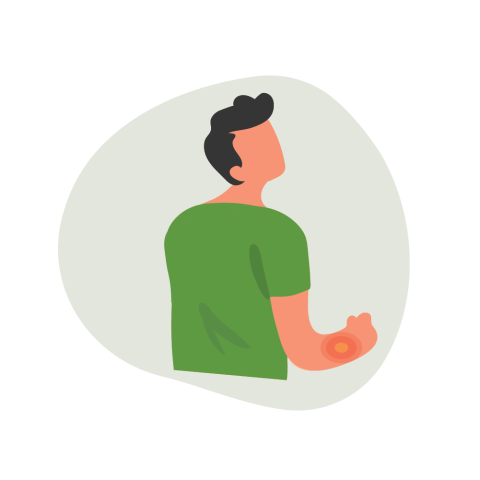Prevent Burns
Treat Minor Burns
When to Get Help
There are many sources of potential accidental burns in the home, and they’re not just caused by a fire. The National Institutes of Health reports that about a half-million people nationwide seek medical attention for burns every year.
There are three types of burns, which are identified by how large an area it covers and how deep the damage goes. You can care for most minor first or second-degree burns at home.
- First-degree burns affect only the thin top layer of skin. These burns may turn red, swell and you may experience pain.
- Second-degree burns include the thick lower layer of skin. These burns may blister, turn red, will usually swell and be painful.
- A third-degree burn is the most serious; it penetrates the entire thickness of the skin, permanently destroying it and the tissue that’s underneath. These burns require immediate medical attention.
You can take steps to avoid household burns.
Steps to Prevent Burns:

- Never leave cooking food unattended on the stove. Turn pot handles away from the stove’s edge.
- Use long oven mitts when removing things from your oven or stove.
- Use care opening hot food items that are tightly sealed like microwaved food or pre-wrapped convenience meals.
- Prevent scalds from hot liquids like soups or beverages by keeping them far from the edge of a table or counter.
- Keep children at least3 feet away from stoves, grills, campfires, firepits and fireplaces.
- Unplug objects like an iron or hair styling device when not in use, and make sure they cannot be pulled down or knocked over.
- Keep appliance cords out of the reach of children.
- Set your water heater’s thermostat to 120 °F or lower to prevent scalding burns.
- Wear sunblock.
- Be careful using chemicals, as some can cause burns.
How to Treat Minor Burns:

- Remove all clothing, diapers, jewelry and metal from the burned area. These can hide underlying burns and retain heat, which can increase skin damage.
- Use cool water, not cold water or ice. The extreme cold from ice can cause additional injury.
- If possible, particularly if the burn is caused by chemicals, hold the burned skin under cool running water for 10 to 15 minutes until it is less painful. Use a sink, shower or garden hose.
- If you don’t have access to cool running water, put a cool, clean wet cloth on the burn, or soak the burn in a cool water bath for five minutes.
- Clean the burn gently with soap and water.
- Do not break blisters. An opened blister can get infected.
- You may put a thin layer of ointment, such as petroleum jelly or aloe vera on the burn. The ointment does not need to have antibiotics in it. Some antibiotic ointments can cause an allergic reaction. Do not use cream, lotion, oil, cortisone, butter, or egg white.
- You can cover the burn with a sterile non-stick gauze lightly taped or wrapped over it. But don’t use one that can shed fibers, because they can get caught in the burn. Change the dressing once a day.
When to Get Help:
See a doctor, call 911 or go to the hospital if:
- The burn is dark red and looks glossy with a lot of blistering.
- See your doctor or call 911 if the burn is larger than two inches.
- From a fire, an electrical wire or socket, or chemicals
- The burned skin is dry and leathery, perhaps with white, brown, or black patches.
- Contact your provider if you have signs of infection including Increased pain, redness, swelling, discharge, fever, swollen lymph nodes or red streak from the burn.
Burns are susceptible to tetanus. If your last tetanus shot was more than five years ago, you may need a booster shot.


